The new Battery Health Monitoring feature appears to be the flagship feature of macOS Catalina 10.15.5. There's not a lot to it, but here's how it works, where it came from, and what to expect.
With Thursday's second developer beta of macOS Catalina 10.15.5 came the migration of a simplified version of the iOS Battery Health Monitoring feature. It is rudimentary at the moment, and doesn't provide the user with as much information as a third-party utility can, but it is a move in the right direction.
How the macOS Catalina 10.15.5 Battery Health Monitoring feature works
Prior to Thursday's update, the Energy Saver control panel looked like it has for several incarnations of macOS.
As you would expect, the new Battery Health Monitoring feature lives in the Energy Saver control panel, under the Battery tab.
The Battery Health dialog box pops up a very simple box, that is selected by default. It gives very basic information on battery health — in this case, normal — and a toggle to turn the feature on and off.
Apple says that when toggled, it will not charge a Thunderbolt 3 Mac to the maximum extent possible if it lives most of its life plugged in, like this particular MacBook Pro does. On the support page that's accessible through the Learn More button, Apple (briefly) discusses how that the feature helps.
The battery health management feature in macOS 10.15.5 is designed to improve your battery's lifespan by reducing the rate at which it chemically ages. The feature does this by monitoring your battery's temperature history and its charging patterns.Based on the measurements that it collects, battery health management may reduce your battery's maximum charge when in this mode. This happens as needed to ensure that your battery charges to a level that's optimized for your usage— reducing wear on the battery, and slowing its chemical aging.
While battery health management benefits your battery's long-term lifespan, it can also reduce the amount of time your Mac runs on one battery charge when capacity limits are applied. If your priority is making your Mac notebook last as long as possible before recharging, you can turn the feature off.
How this will all work in practice, and the impact it will have on battery life, remains to be seen. We've tried it on a 2016 MacBook Pro with a depleted battery, and it gives us the same information that the computer did before the update when it told us it was time to get a new battery.
Batteries aren't eternal — how they work, and how we got here
Any battery stores electrical energy in the form of chemical energy, and can convert that energy into electricity. A battery requires an anode and cathode, separated by electrolyte that allows the flow of electrical charge between the cathode and anode.
When the battery is put under load, the anode releases electrons to the negative terminal and ions in the electrolyte through an oxidation reaction. The cathode accepts these electrons, completing the circuit for the flow of electrons.
This is the end of the story for non-rechargeable batteries. However, lithium-ion batteries can be recharged. So, when current is properly applied, the electron flow happens in reverse, recharging the battery.
A battery's total capacity measured in milliamp-hours for mobile devices or watt-hours for the Mac. Overall lifetime including charge/discharge cycles are limited by engineering choices made by device manufacturers including charging circuitry and software, plus physical volume of reactants.
The better and more regulated the charging and discharging of the cell is, the longer the battery will live. This appears to be why Apple has implemented this in macOS — to control some of the variables that it can.
There are other factors that can cut down the operational life of a battery. The more temperature excursions the battery endures, like leaving it in a hot car, or outside in freezing temperatures, the shorter the life of the battery will be. And, age itself is a factor.
While this is less relevant for a Mac versus an iPhone, given the volume of the Mac battery, the output voltage of any given battery over a discharge cycle can be plotted over percent charge.
Battery reactants aren't eternal. In the case of a lithium-ion battery, "metal whiskers" can form in the cell, shorting out afflicted portions of the battery cell and cutting down on available power. Ultimately, the whisker formation, coupled with reactant depletion lead to a completely dead battery from under-voltage and non-reversible oxidation.
Battery wear from any factor shrinks the horizontal axis of the above graph. Obviously, device power demand decreases the amount of time it takes to progress along the curve on any given charge.
Damage to the cell from the environment, faulty charging gear providing more than allowable voltage, or other issues permanently increases the steepness of the voltage drop while the battery is being used. Operating temperature has a temporary increase in steepness as well, with low temperature having more of an impact on capacity than high.
Without delving too deeply into battery manufacture, device manufacturers have to make choices based on the performance curve. Battery capacity and output voltage are two different things that have to be considered, to say nothing of safety factors.
Every device has a critical voltage, at which point it won't stay operational, may lose data, or crash entirely. On a device designed to be plugged into power for most of its life, this is less of an issue. But, the critical voltage varies from device to device depending on the device and the battery — and is not just applicable to Apple.
As to how we got here, Apple decided to take some action on iOS to mitigate the impact of this curve, which would turn out to be a problem. Apple implemented a shutdown fix in February 2017 with the release of iOS 10.2.1. What it did was temporarily down-clock the CPU in the phone when it was under load to keep the device's voltage demand less than the critical voltage where the phone would shut down seemingly at random.
Despite the inescapable reality of battery chemical depletion, Apple didn't effectively communicate what it was doing to the users with the patch, though. At the time of release Apple instead just said that it fixed the random shutdown problem, until benchmarking older phones discovered the impact of the patch.
After admitting in December 2017 that some software changes were made to prevent shutdowns, Apple apologized and offered reduced out-of-warranty battery replacements at $29. And, as a result, Apple had to pay out some cash to aggrieved lawsuit filers.
Now that we're here, now what?
Inclusion of the Battery Health Monitoring is a good thing — so far. While the Mac is theoretically impacted by the critical voltage issue like any other device, as a general rule the batteries don't age as quickly as they will on a significantly smaller mobile device and it takes longer to hit that critical voltage. And, if you use your MacBook Pro or MacBook Air connected to power for most of its life, even when the battery is effectively completely depleted, you may not even notice unless the OS tells you.
We'll see what happens with time, of course. This will be a game of seconds and watts adding up over years, and it will be hard to draw any conclusions on the effectiveness of the new routines in macOS in the short term. For now, it isn't going to make us give up our CoconutBattery install, though.
 Mike Wuerthele
Mike Wuerthele
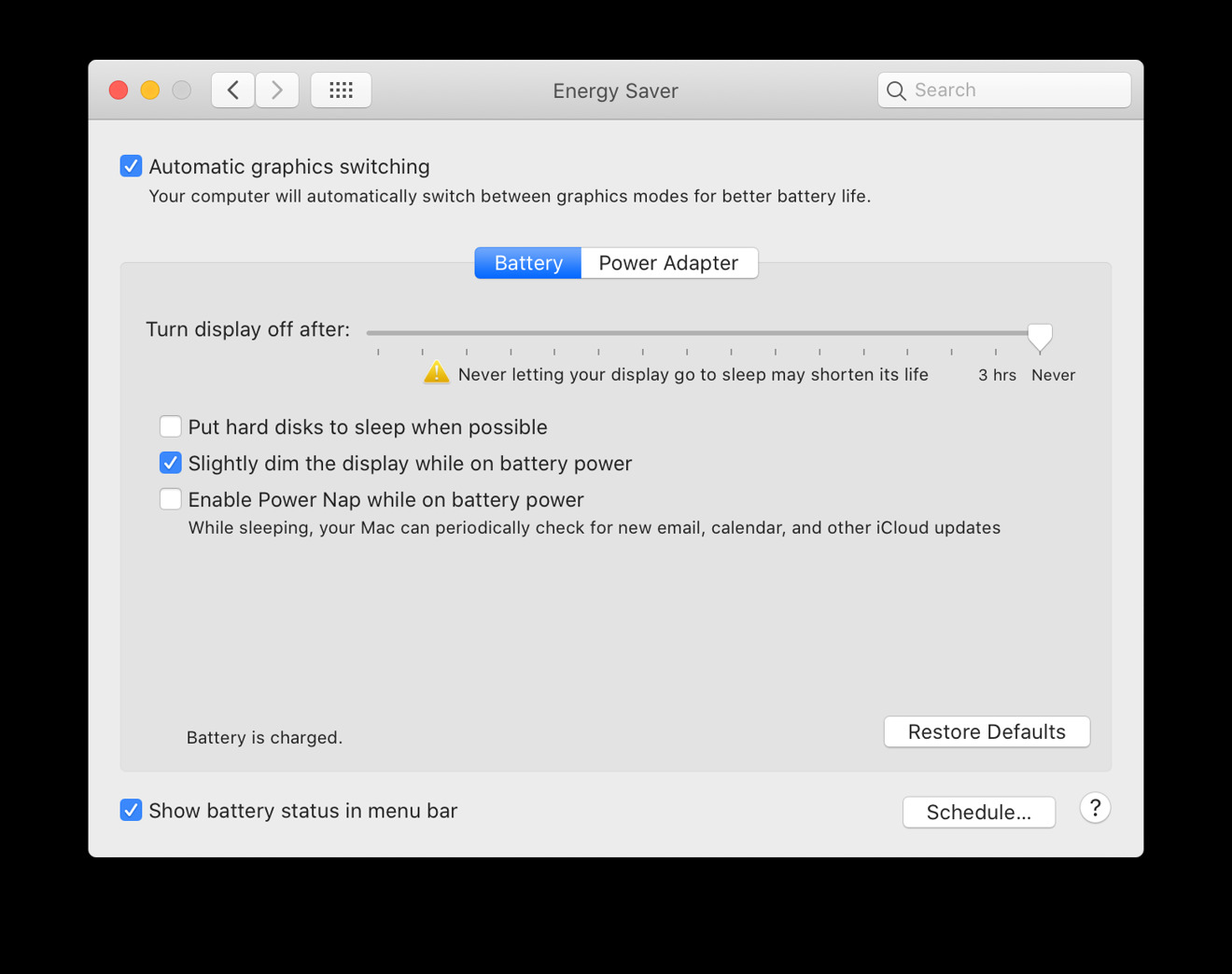
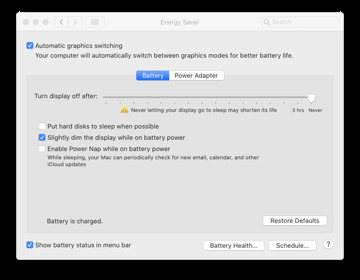
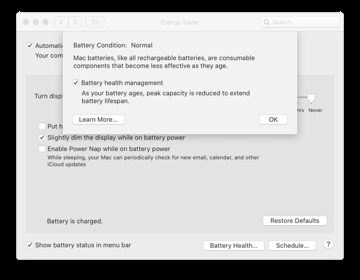
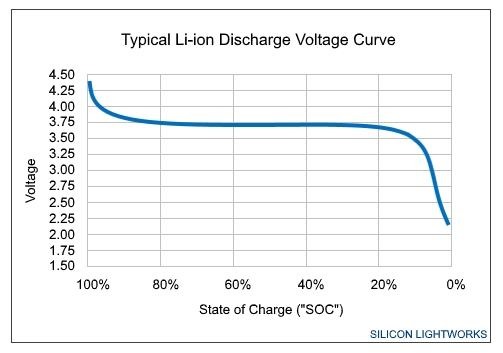

-m.jpg)





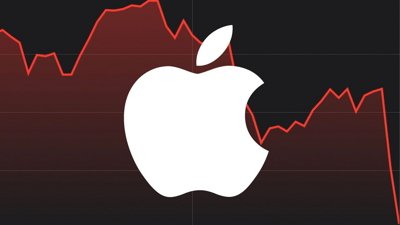
 William Gallagher and Mike Wuerthele
William Gallagher and Mike Wuerthele
 Andrew Orr
Andrew Orr
 Malcolm Owen
Malcolm Owen
 Amber Neely
Amber Neely

 Wesley Hilliard
Wesley Hilliard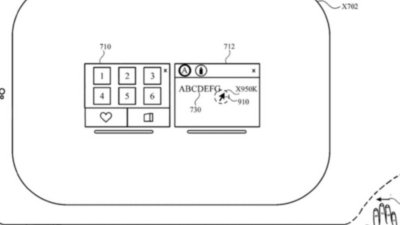
 William Gallagher
William Gallagher










15 Comments
This is cool. People shouldn't let battery health impinge on their lives. This will increase the useful lifetime of the battery beyond what a person could ever manage to do on their own (and still have a life!) Great to see this technology migrated from iOS/iPadOS to macOS.
Curious to see how my 2012 retina’s original battery stands up. Some app off the App Store says it’s at 84%.